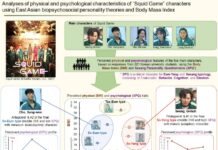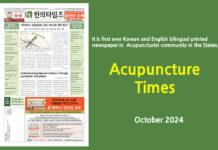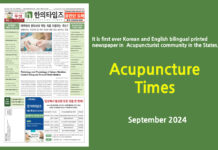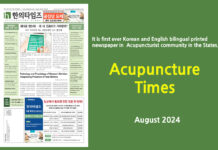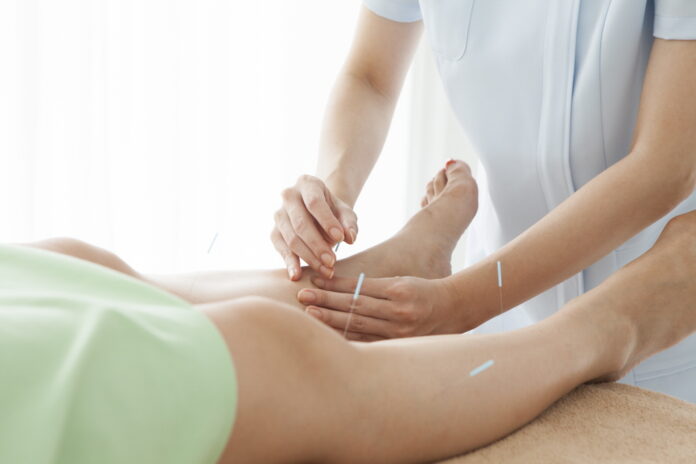- Hyo-Jung Kwon, Yong-Suk Kim*
Department of Acupuncture & Moxibustion, (Brain & Neurological Disorders and Pain), Kangnam Korean Hospital, Kyung Hee University, Seoul, Korea - Open Journal of Immunology, 2015, 5, 90-103
2.1. Example in Deficiencies
1) Needle 1: Tonify the deficient Meridian at its mother (tonification) point. With a Lung Meridian deficiency, tonify the Earth point of the Lung Meridian, LU6.
2) Needle 2: Tonify the master point on the Mother Element Meridian. With a Lung Meridian deficiency, the Mother of Metal is Earth, hence the Mother of Lung is Spleen, and the master (Earth) point of the Spleen (Earth) Meridian, SP3, should be tonified.
3) Needle 3: Sedate the Controller Element on the affected Meridian. With a Lung Meridian deficiency, the Controller of Metal is Fire, so the Fire point on the affected Meridian, LU10, should be sedated.
4) Needle 4: Sedate the master point on the Controller Element Meridian. With a Lung Meridian deficiency, the Controller Element is Fire, hence the Controller of Lung is Heart, and the master (Fire) point of the Heart (Fire) Meridian, HT8, should be sedated.
2.2. Examples in Excesses
1) Needle 1: Sedate the affected Meridian at its Child Element point. For Liver excess, sedate the Fire (Child) point of the Liver Meridian, LR2. 2) Needle 2: Sedate the master on the Child Element Meridian. For Liver excess, the Child of Wood is Fire; hence the Child of Liver is Heart. The master (Fire) point of the Heart, HT8, should be sedated.
3) Needle 3: Tonify the Controller Element on the affected Meridian. For Liver excess, the Controller of Wood is Metal, so the Metal point on the affected Meridian, LR4, should be tonified.
4) Needle 4: Tonify the master point on the Controller Element Meridian. With Liver excess, the Controller Element is Metal, hence the Controller of Liver is Lung, and the master (Metal) point of the Lung (Metal), LU8, should be tonified. To summarize the principle for deficiency conditions [19]: Tonify the first two needles—tonify the Mother Element Five Shu point on the affected Meridian, and then tonify the master point on the Mother Element Meridian; Sedate the second two needles—sedate the Controller Element Five Shu points on the affected Meridian, and then sedate the master point on the Controller Element Meridian. For example, if the Stomach is believed to be hypounderactive: (1) for Fire tonification, Stomach Meridian-Fire point ST41, Small Intestine Meridian-Fire point SI5; (2) for Wood sedation, Stomach Meridian-Wood point ST43, Gall Bladder Meridian-Wood point GB41 should be used. The other Meridians follow the same rule, as described above. To summarize the principle for excess conditions: Sedate the first two needles—sedate the Child Element Five Shu points on the affected Meridian, and then sedate the master point on the Child Element Meridian; Tonify the second two needles—tonify the Controller Element Five Shu points on the affected Meridian, and then tonify the master point on the Controller Element Meridian.
2.3. Controller Element Meridian
For example, if the stomach is believed to be overactive: (1) for Metal (son) sedation, Stomach Meridian-Metal point ST45, Large Intestine Meridian-Metal point LI1; (2) for Wood tonification, ST43 and GB41 should be used. The Gall Bladder Meridian is opposed to the Stomach Meridian by the control (destructive) cycle of the law of the Five Elements (the governor Meridian), so the Wood point of Gall Bladder Meridian, GB41, destroys the element of Earth within the self-Meridian. The other Meridians follow the same rule described above (Table 3).
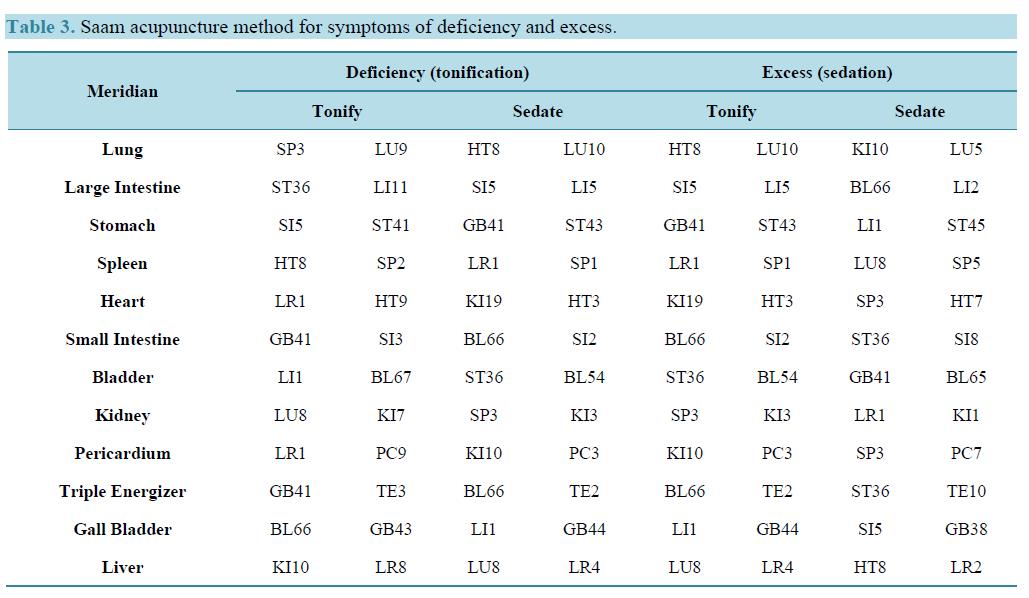 Some kinds of diseases are caused by the imbalance between heat and coldness in the body and the corresponding treatments consist of using the Water and Fire Element Five Shu points along the Meridian in question, the Water Element Meridian, and the Fire Element Meridian. For a heat symptom, the Water point of the self Meridian and that of the Water Element Meridian are selected to tonify Water, as well as the Fire points of the self and Fire Element Meridians selected to sedate Fire. For a cold symptom, the Fire points of the self and Fire Element Meridians are selected to tonify Fire, as well as the Water point of the self-Meridian and that of the Water Meridians selected to sedate coldness.
Some kinds of diseases are caused by the imbalance between heat and coldness in the body and the corresponding treatments consist of using the Water and Fire Element Five Shu points along the Meridian in question, the Water Element Meridian, and the Fire Element Meridian. For a heat symptom, the Water point of the self Meridian and that of the Water Element Meridian are selected to tonify Water, as well as the Fire points of the self and Fire Element Meridians selected to sedate Fire. For a cold symptom, the Fire points of the self and Fire Element Meridians are selected to tonify Fire, as well as the Water point of the self-Meridian and that of the Water Meridians selected to sedate coldness.
In the case of cold symptoms in the Lung, the coldness symptom can be balanced by both the tonification of heat and sedation of coldness. Accordingly, the Fire points, LU10 of the self-Meridian and HT8 of the Fire Element Meridian, should be tonified to warm “coldness.” Conversely, the Water points, LU5 of the self-Meridian and KI10 of the Water Element Meridian, should be repressed. The other Meridians follow the same rules described above.
In the case of heat symptoms in the Lung, the Fire symptom can be controlled by Water, and the Water points, LU5 of the self-Meridian and KI10 of the Water Element Meridian should be tonified. Conversely, the Fire points, LI10 of the self-Meridian and HT8 of the Fire Element Meridian, should be repressed. The other Meridians follow the same rule described above (Table 4).
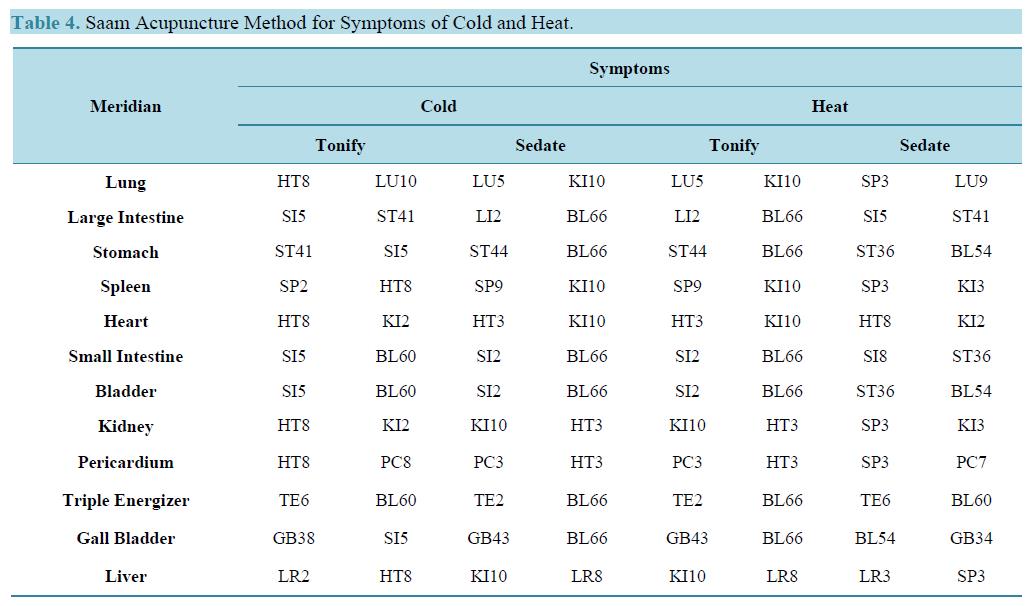
3. Method of Tonification and Sedation
Saam acupuncture is applied with stimulation techniques such as respiratory, rotational and directional methods. Each stimulation results in tonification or sedation. Tonification and sedation occur depending upon clockwise or counter-clockwise rotations in accordance with direction of Meridians. Tonification occurs following the insertion of a needle as the patient exhales and removal at inhalation. Sedation occurs on insertion of the needle as the patient inhales and removal on exhalation. Tonification occurs when the needle is inserted in the inclined position following the direction of the flow of Qi in the Meridian. By contrast, sedation occurs following insertion of the needle in the inclined position in the opposite direction to the flow of Qi in the Meridian [2]. In theory, the use of acupuncture stimulation may be possible in treatment but strong technical movements on acupoints located on shallow body surfaces, such as between finger tips and elbow or tips of toes and knee, may be hard for the practitioner to access. Clinically it is recommended that practitioner do not use strong stimulations. A simple and weak stimulation seems to be enough to gain the acupuncture effect.
References
[2] Kim, D.-H. and Kim, J.-H. (1993) The Literary Study on the Written Date of and the Background of Sa-Ahm’s 5 Element Acupuncture Method. Kyungwon University, Kyungki.


